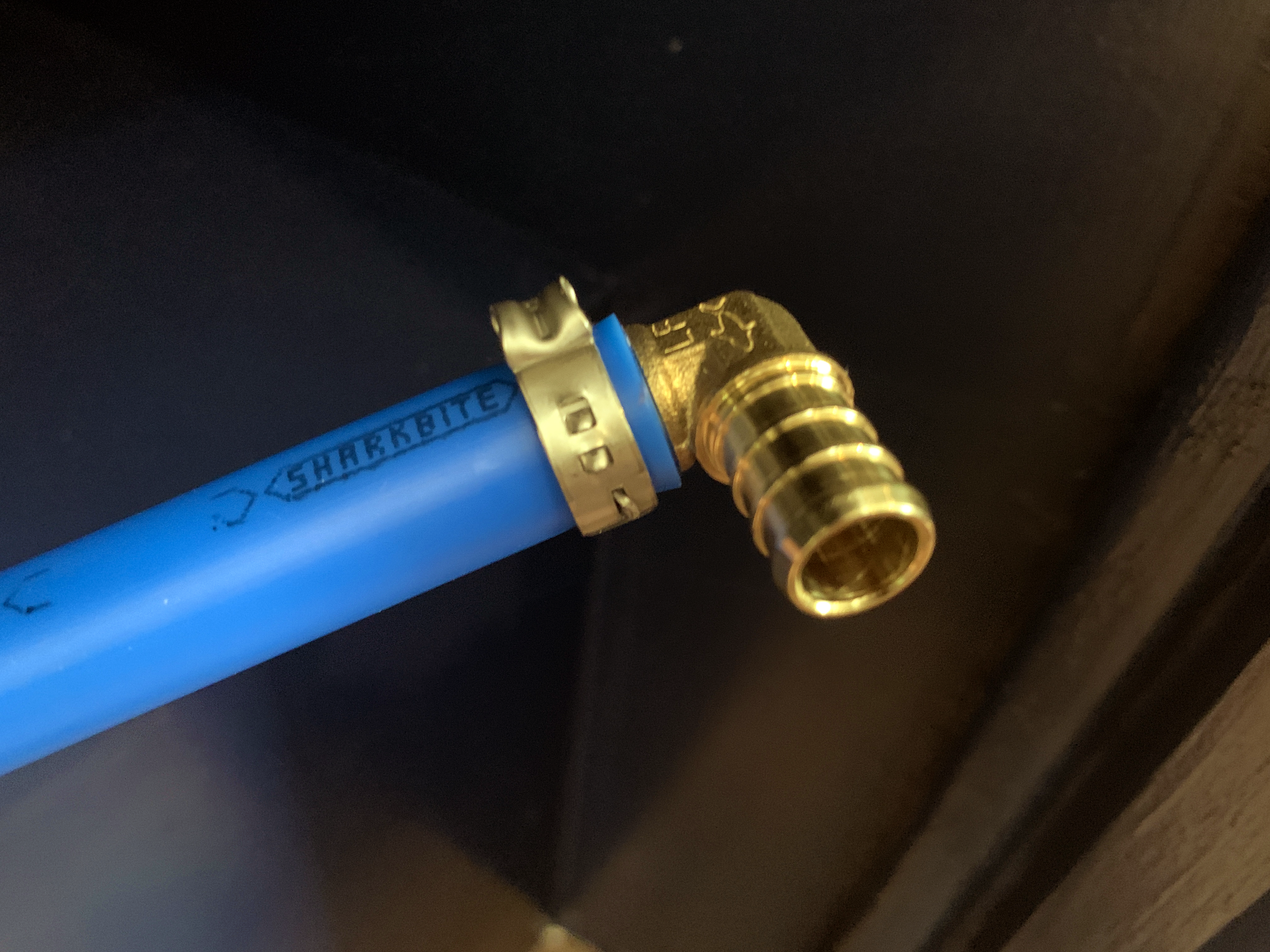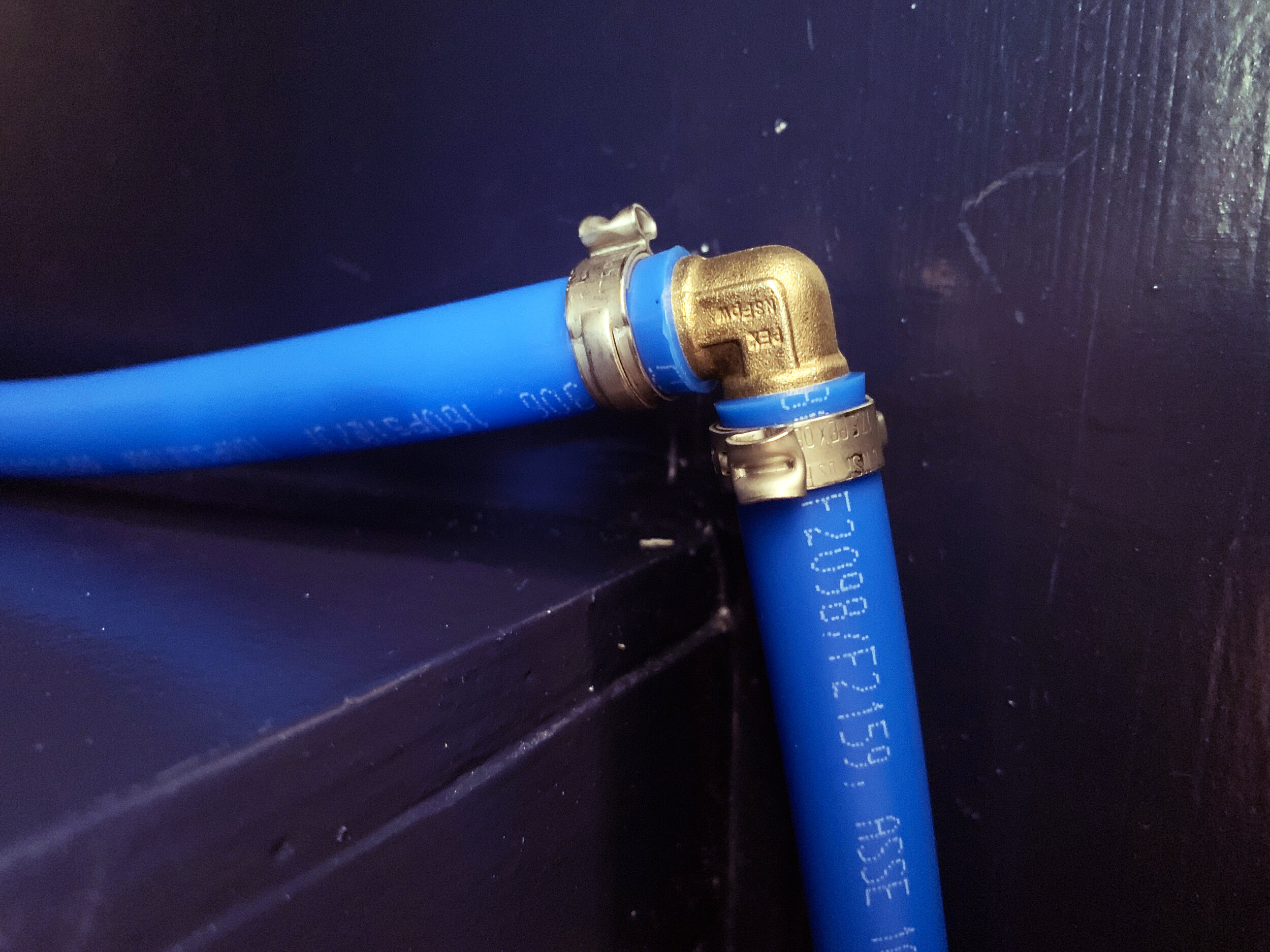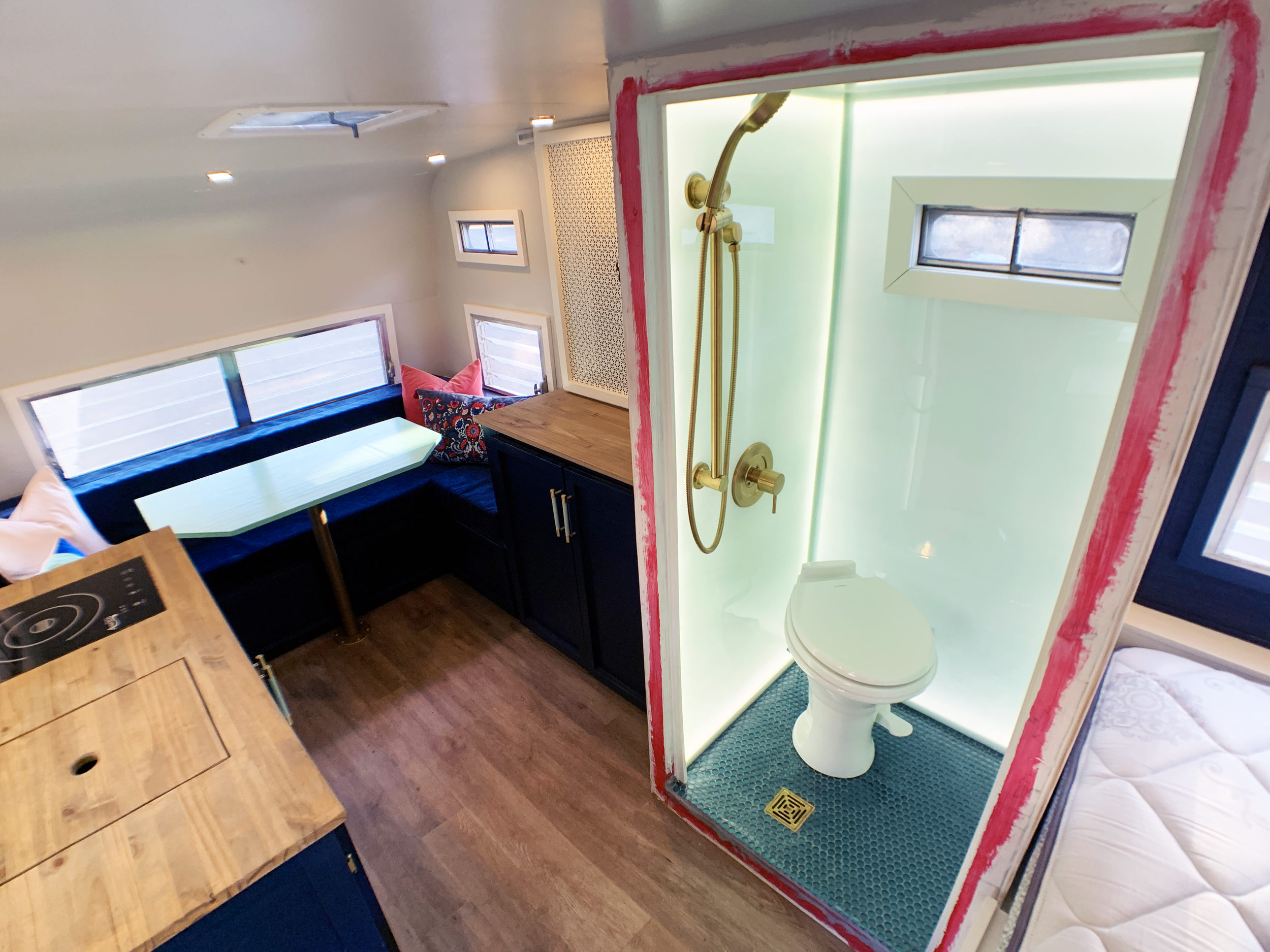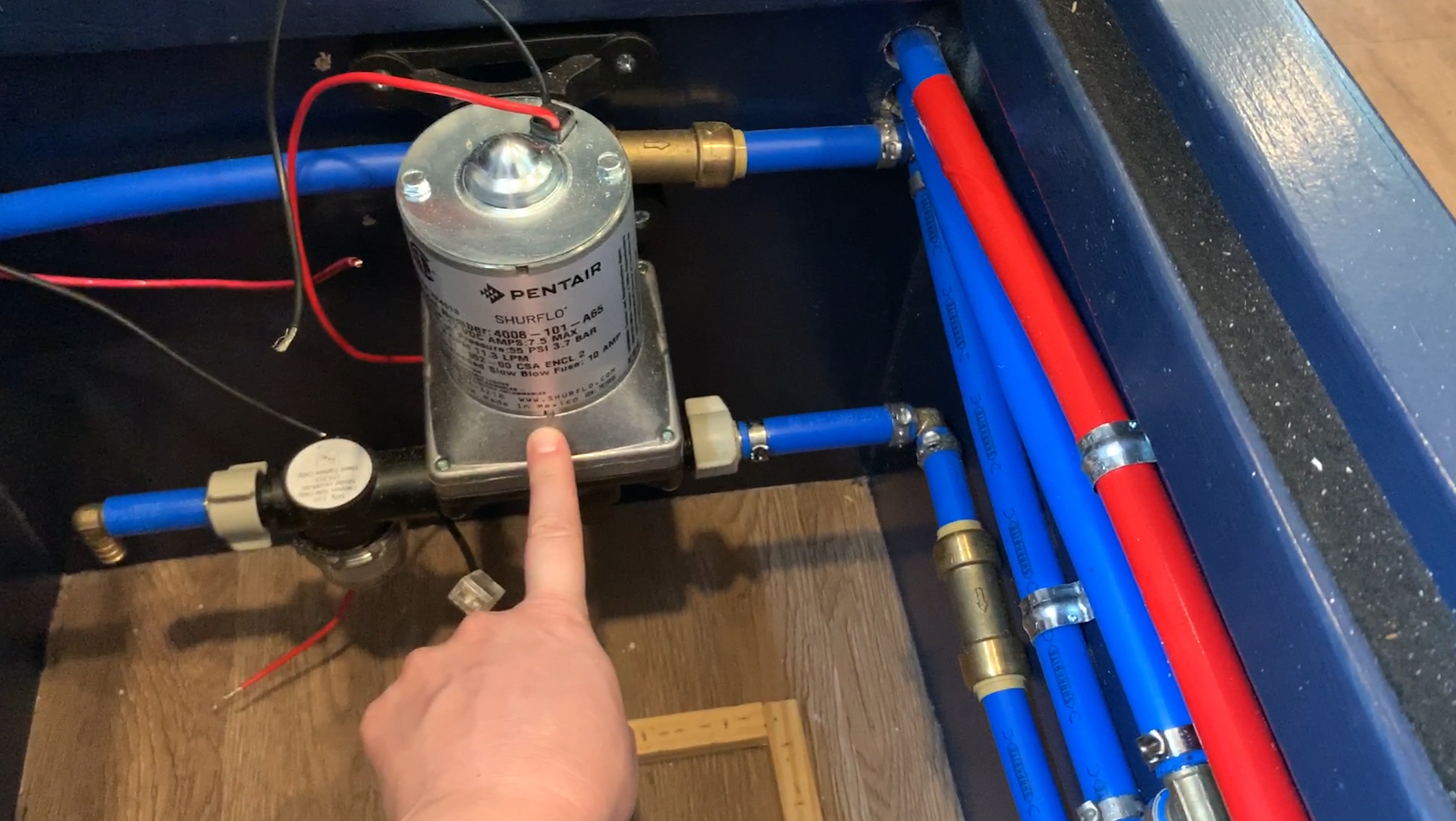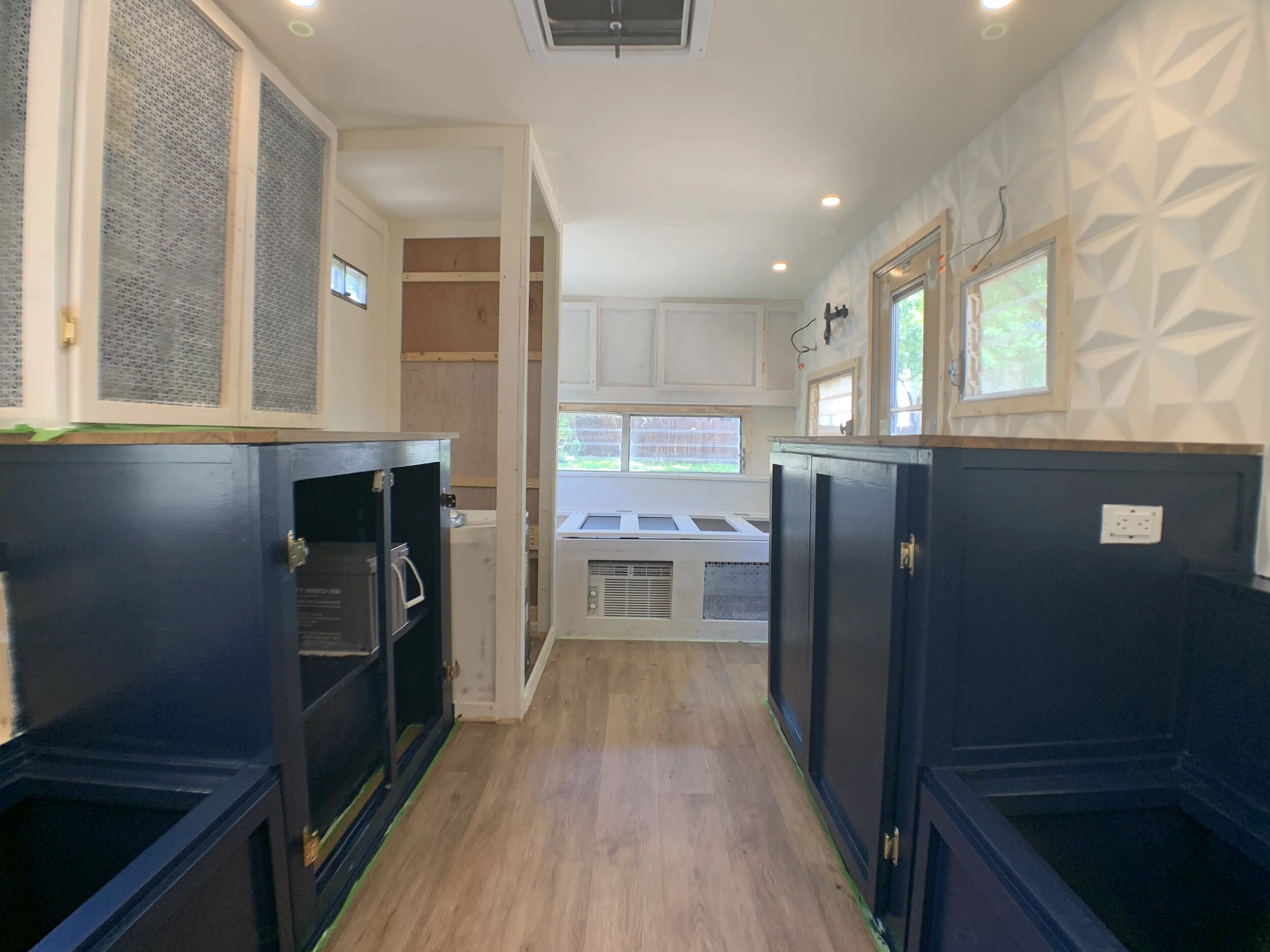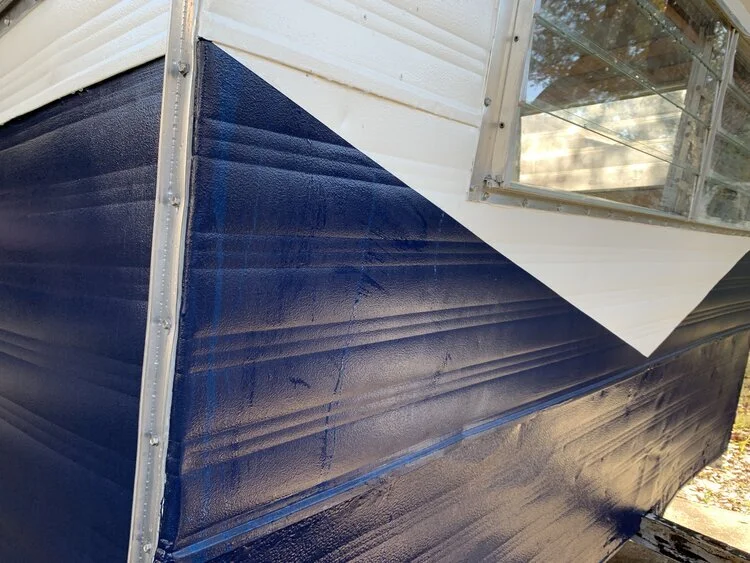The Cameo Camper Renovation: Let's talk about PEX
Let’s talk about PEX baby, let's talk about cold and heat, let's talk about all the good things and the bad things that may be … let’s talk about PEX. Let’s talk about PEX. And yes, I may or may not have had this awesomely nerdier version of the song stuck in my head during the entire plumbing project … and maybe some, okay all, of the rest of our entire vintage camper renovation.
Ok, now that that's finally out of my system, let's actually really talk about PEX…
So, what the heck am I talking/singing about?
Today we’re sharing how we ran our interior water lines (or PEX pipe), how we used the special tools and some tips and tricks we learned during install.
What is PEX?
If you've been following along, you know we gutted all of the things after finding a lot of water damage, and that includes the plumbing that was already kind of demo’d by the time we were The Cameo’s owners. Enter PEX pipe.
So what exactly is it? According to sharkbite.com (the folks who make PEX), “SharkBite® PEX pipe is a cross-linked polyethylene tubing that provides an excellent option for plumbing, radiant and hydronic systems in both residential and commercial plumbing applications. When combined with our push-to-connect fittings, manifolds, valves and other supplies, PEX pipe offers the fastest way to plumb any project. PEX pipe is made from cross-linked HDPE (high density polyethylene). The HDPE is melted and continuously extruded into a tube to form a high-performing pipe suitable for a variety of potable and non-potable plumbing applications.”
Yeah, what they said.
TLDR: Basically PEX pipe is tubing that is used for plumbing that is much easier to use and install than more traditional plumbing materials, plus it's super lightweight and strong, more resistant to breakage caused by freezing than both copper or PVC pipe (great for a camper) AND you can get it in different colors so you can quickly and easily tell which lines are cold and which are hot water. Anything that is a pressurized water line should be PEX pipe (and definitely not flex tubing).
OUR PEX-RELATED SHOPPING LIST:
(This only includes the main PEX-related items we used to plumb our camper and does not include all of the materials for the entire plumbing system we cover here.)
1/2” PEX pipe – PEX pipe comes in different sizes, and 1/2” is pretty standard and plenty big for what we’re doing here. The length needed will vary depending on the size of your camper, distances the lines need to run, etc. It also comes in different colors (red, white/clear and blue). Because we needed more than 10-foot runs and not more than one roll, we opted to just go with blue (the majority of our lines are cold/neutral temperature) and tape our hot lines with red duct tape as needed (mostly for educational purposes to show you what is cold and what is hot in our photos/videos).
PEX cutter tool – for 1/2” PEX pipe; You could also buy a nicer one (especially if you’ll be cutting a ton of PEX professionally and/or need to also cut copper or something), but the more compact, cheaper one (at 1/4 of the cost) worked well for our use of cutting just PEX, sometimes in tight spaces.
PEX stainless steel clamp rings (or quick connects) – I’m guessing we used around 100 rings (maybe a little more?) to run water through our 14’ camper; from the water tank area under the bench to and from our shower/wet bath and to and from our kitchen sink. The amount of clamps needed depends on the amount of connections you have. We pretty much needed 1 ring for each cut made in our PEX pipe. (A few PEX lines went into quick-connects which don’t require the clamping rings, but for us that was the exception, and we tried to use the quick connects sparingly since they are way expensive, comparatively. We figure the quick connects are more for repairs since they’re so pricey, but the plus side to the quick connects are if you mess up, you don’t waste the fitting, the ring, and the PEX pipe it’s connected to, unlike with the PEX clamp rings.)
3-handle 3/8”-1” PEX clamp tool – for crimping rings around connectors
1/2” PEX brass barb connectors
1/2” x 1/2”elbows – part #UC248LFZ for the single or part #UC248LFA10 for the 10-pack – (we used 24)
1/2” x 1/2” x 1/2” tees – part #UC362LFZ – (we used 3)
(2) brass back-flow preventers/check valves – an example of one type of push-to-connect fitting
1/2” PEX disconnect clip – removes the push-to-connect type of fittings (like the backflow preventers/check valves and PEX-to-threaded ABS adapters) without damaging the pieces
You will likely also need some of the various PEX-to-threaded ABS fitting adapters below, which connect to PEX pipe the same as the elbows and tees above do as outlined below.
1/2” x 1/2” MNPT male adapter – part #UC120LFZ – (we used 3 – 1 for connecting our drain to the tank and 2 to connect the hot and cold PEX lines to our sink’s water lines)
1/2” x 1/2” FNPT elbow female swivel – part #UC532LFZ – (we used 1 right behind the exterior water-in port to bend our pressurized city PEX line down into our bench’s backrest)
1/2” x 1/2” FNPT female adapter swivel – part #UC526LFZ – (we used 5 – 2 for connecting to the water heater, 2 for either side of the water pump and 1 to connect to back of the toilet)
1/2” CTS / 1/2” NPT Aqualock push-to-connect male adapter* – part # VTS-733 – (we used 2 to connect our fresh tank fittings – the drain and out port to the water pump – to 1/2” PEX pipe). *Note: we bought “the same thing” from Lowes and it was smaller for some reason. Vintage Trailer Supply is the only place we found one that is the size we needed.
1/2” PEX ball valve – for the fresh water tank drain – part #22461LFZ – (we used 1 under the camper floor for our tank drain)
U-shaped metal straps – to help secure PEX pipe to our cabinets
You could also use these for support, which are specifically made for PEX:
Plastic PEX bend supports – for any curves you may have
Working with PEX
Fortunately, PEX pipe and the coordinating fittings are very easy to work with since there’s no soldering or sweating needed, and as long as you have the right tools (true with any job) it’s a total breeze!
Cutting PEX pipe
Cutting the PEX is pretty simple – as long as you have the space to do it. Whenever we could we cut unconnected sections of PEX pipe in open space, as the cutter needs room to spin in circles around the pipe. This is true for both the length and width of the tool. (You’ll see what I mean about width in a bit.)
To cut the pipe segments, after measuring and marking our length on the PEX with a Sharpie, we opened up the mouth of the cutting tool by squeezing the textured handle end, lined up the blade (hidden inside the round hole) with the Sharpie line on the tubing and spun the cutter around the PEX.
Important
Make sure you’re spinning the PEX cutter as square/perpendicular to the pipe as possible so it doesn’t “walk” around and make multiple shallow scored lines and in the direction of the arrow on the cutting tool to get a nice clean cut.
And just like that, in a few spins it will easily cut all the way through.
You can also add a little pressure with your hand as you spin it (especially as you use it more and more and the blade begins to dull a bit) on the outside plastic of the blade area to get a quicker/cleaner cut in fewer spins. Just make sure you keep your fingers out of the mouth area where the blade is!
Remember when I mentioned making sure you had space for the cutter’s length and width? You can see in the photo below, we needed to make a very short cut for our PEX line coming into the shallow shower wall from the water heater cabinet. (As the tool spins around the PEX pipe, the length of the handle could hit the wall on the right if it were too long keeping us from making a nice, clean cut all the way around, and the width of the cutter dictated how close we could get to the side of the cabinet, and therefore how short that piece of PEX pipe could be.)
Thankfully, we were able to just make this cut work, but it’s little things like always being aware of your next connection that you have to think about before you lock in the PEX lines in such a tight space. (This is less of an issue if you use the pricier push-to-connect fittings over the clamp rings and brass fittings we used as they can be removed and reused with a little tool.)
Connecting Sharkbite brass barb fittings
We used this instruction video from Sharkbite to learn how to use the tools and clamp rings.
FYI
We used the lead-free brass fittings and stainless steel clamp rings (not the crimp rings) mentioned in the video below. Also, they show how to use the pricier, pliers-style cutting tool, not the spinning type we used and showed above.
Like they mention in the video, with the brass connector fully inserted until it reaches the fitting shoulder (the noticeably larger ridge where you won’t be able to push it in anymore), the clamp rings should be placed 1/8” - 1/4” from the cut edge of the PEX pipe to make a tight seal onto the brass Sharkbite connector.
With the tip of the clamping tool fully on the ring nob, push down on the handle all the way. You’ll feel when the ring is properly clamped because the clamping tool will ratchet down and then pressure release when it’s made the perfect clamp on the PEX pipe.
If you’re unsure, you’ll also see a pretty sizable dent in the little nob on the clamp ring. In the photo below you can tell the new, untouched ring on the right is not clamped because of the small size of dent on the top of the nob (not to mention it’s not attached to any fittings or end caps), versus the ring on the left that is securely clamped and has a big dent on the top of the nob that almost looks like a bowtie.
Connecting Sharkbite push-to-connect fittings
We didn’t use many of these, but they are as easy to use as they sound. You just push the PEX pipe into the fitting to make a waterproof connection.
Important measurements
Because we often found ourselves in tight spaces and needing to frequently remember (which meant remeasure) our minimum lengths, we thought it would be helpful to share with you some important figures we used repeatedly to help you plan your plumbing in a tight space.
Brass barb connector minimum length
The minimum length of a section of PEX pipe connected to one brass Sharkbite fitting is 5/8”, as the brass part that inserts into the pipe is 5/8” long. That means, to have a segment with a brass fitting on each end touching tip to tip inside, the PEX pipe needs to be at least 1.25” long.
Push-to-connect minimum length
According to the table below from Sharkbite, the length of PEX pipe needed to fit inside a push-to-connect fitting for 1/2” diameter PEX is .95”. That means, however long your overall length of piping for that segment needs to be, don’t forget to add at least an additional .95” (per push-to-connect fitting!) to your exposed PEX line length that will need to slip down into the push-to-connect fitting to make a nice connection.
Push-to-connect fittings + brass barb connectors
We do have at least one instance where we needed a tiny section of PEX pipe used where one side is a push-to-connect fitting and the other is a brass barb connector. Because one fitting is a female (the push-to-connect), and one is a male (the brass barb) we were able to sort of fudge the minimums mentioned above, overlapping the fittings a little bit where the brass fitting is inside the PEX pipe and also kind of inside part of the push-to-connect fitting.
Almost like a less tasty turducken situation – or, at least I assume as I haven’t tried to eat either. Instead of a chicken inside of a duck inside of a turkey, we have a brass fitting inside of a PEX pipe inside of a push-to-connect fitting.
PEX FAQs
The following FAQs related to our project were pulled directly from Sharkbite’s resources page and were accurate at the time of this writing.
Is PEX pipe freeze resistant?
Yes, PEX pipe is freeze-damage resistant. PEX pipe will expand if frozen and contract to its original shape when thawed. PEX pipe is not freeze-proof. You should use the same standard insulation precautions with PEX pipe to help prevent freezing.
Can I use PEX outside?
PEX pipe is not approved for outdoor applications and is not approved for continuous UV exposure. PEX pipe should not be stored in direct sunlight.
Can a SharkBite fitting be rotated on the pipe?
Yes. SharkBite fittings can be rotated after installation. Rotating the fitting will not affect the integrity of the joint.
How it’s holding up
We’ve gotten some questions about whether the type of connections we used are right for a moving/vibrating camper – from our research it seems the PEX system is the current standard for pressurized lines for RV and marine plumbing since it is a cost-effective, lightweight and flexible option that’s more resistant to breakage caused by freezing than both copper or PVC, and so far we have not had any leaks or issues with our PEX lines or connections. (Yay!)
Should any of that change, we’ll update y’all with any adjustments we make, etc.





